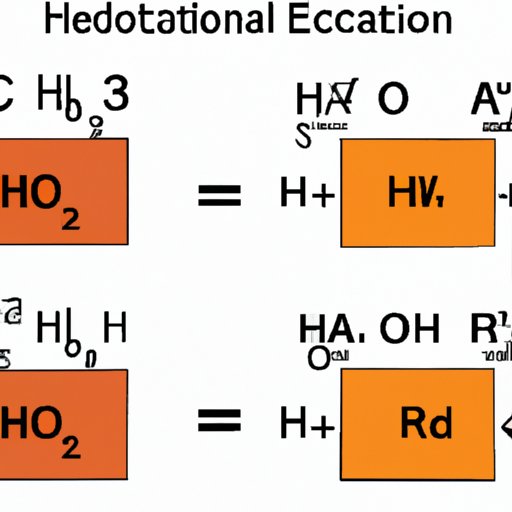Introduction
Half reaction equations and oxidation are fundamental concepts in chemistry that play an essential role in various scientific studies and industrial applications. In this article, we will explore the science behind these concepts, their relationship, and most importantly, how to determine the oxidation half reaction equation.
Exploring the Science Behind Half Reaction Equations and Oxidation
Half reaction equations are a way of describing the movement of electrons in a redox reaction. In simple terms, these equations show the transfer of electrons from one substance to another. On the other hand, oxidation is the loss of electrons by a substance, resulting in an increase in oxidation state.
Oxidation and reduction always occur together in redox reactions, and half reaction equations are used to separate these processes. Understanding these concepts is crucial because they form the basis of virtually all chemical processes, biological reactions, and industrial applications.
Unraveling the Mystery: Determining the Oxidation Half Reaction Equation
Determining the oxidation half reaction equation is one of the essential steps in understanding and balancing redox reactions. To determine the oxidation half reaction equation, you need to ensure that the electrons are moving from the substance being oxidized to the oxidizing agent, and that the number of electrons lost equals the increase in oxidation state.
For example, consider the reaction between zinc and hydrochloric acid:
Zn + 2HCl ⟶ ZnCl2 + H2
The oxidation half reaction for this reaction is:
Zn ⟶ Zn2+ + 2e–
In this case, zinc loses two electrons and undergoes an increase in oxidation state from zero to +2. These electrons are then gained by the hydrogen ions, resulting in the formation of hydrogen gas.
It is important to note that determining the oxidation half reaction equation requires practice and a solid understanding of the concepts involved. Common errors to avoid including incorrectly identifying the oxidizing agent and reducing agent, misunderstanding the changes in oxidation states, and failing to balance the equation correctly.
Breaking Down the Chemistry: Identifying the Oxidation Half Reaction Equation
Identifying the oxidation half reaction equation requires a sound understanding of oxidation states. An oxidation state is a measure of an atom’s or ion’s loss or gain of electrons. It is represented by a positive or negative number that reflects the degree of electron sharing between atoms.
The key to determining the oxidation half reaction equation is to identify the atoms or ions that undergo a loss of electrons, resulting in an increase in oxidation state. For example, in the reaction between sodium and chlorine:
2Na + Cl2 ⟶ 2NaCl
The oxidation half reaction for this reaction is:
Cl2 + 2e– ⟶ 2Cl–
In this case, chlorine gains two electrons and undergoes a decrease in oxidation state from zero to -1. These electrons were lost by the sodium atoms, which undergo oxidation and an increase in oxidation state from zero to +1.
The Importance of Half Reaction Equations in Deciphering Oxidation
Half reaction equations are essential tools for understanding oxidation and reduction in redox reactions. They allow chemists to identify which atoms or ions are undergoing changes in oxidation state and to ensure that the overall reaction is balanced correctly.
Furthermore, half reaction equations are widely used in various industrial processes, including corrosion prevention, electroplating, and the production of chemicals such as chlorine and hydrogen. A solid understanding of these concepts is therefore essential in these fields.
Solving the Puzzle: How to Determine the Correct Oxidation Half Reaction Equation
To determine the correct oxidation half reaction equation, follow these steps:
- Identify the oxidized and reduced species in the reaction
- Write the half reaction equation for the species undergoing oxidation and reduction
- Balance the half reaction equation by adding electrons to one side to ensure that the number of electrons lost equals the number gained
- Ensure that the overall reaction is balanced by adjusting the coefficients of each half reaction equation
When determining the oxidation half reaction equation, it is important to avoid common mistakes such as forgetting to include the states of the reaction components, incorrectly identifying the oxidizing and reducing agents, and forgetting to balance the overall reaction correctly.
Finally, a few tips and tricks for determining the oxidation half reaction equation include practicing regularly, mastering the concept of oxidation states, and using mnemonic devices to help remember the steps involved.
Conclusion
Half reaction equations and oxidation are essential concepts in chemistry and play an important role in various scientific and industrial applications. Determining the oxidation half reaction equation is crucial in understanding and balancing redox reactions, and mastering these concepts requires practice and a solid understanding of the underlying chemistry.
In summary, we have explored the science behind half reaction equations and oxidation, discussed how to determine the oxidation half reaction equation, broken down the chemistry behind identifying the oxidation half reaction equation, and highlighted the importance of these concepts in deciphering oxidation. By following the steps outlined in this article and avoiding common mistakes, you can quickly and easily determine the oxidation half reaction equation in any redox reaction.
